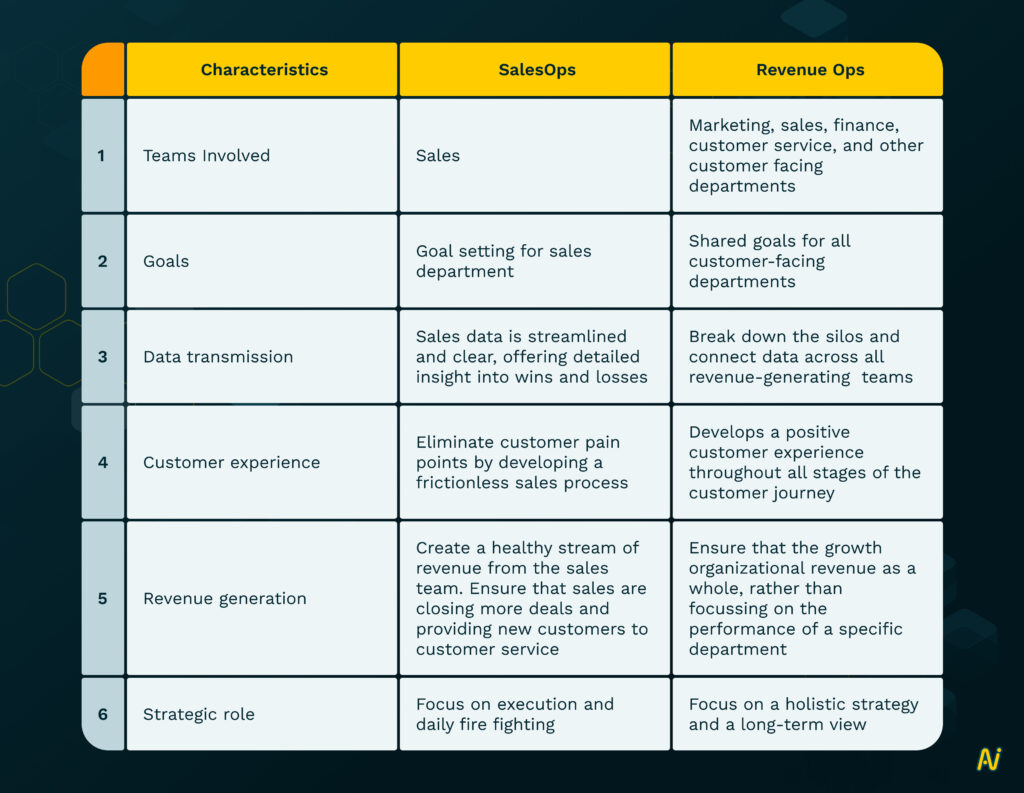Imagine two departments in an organization working to increase the company’s revenue. Both affect the bottom line, eliminate departmental silos, and support business strategies and objectives.
But both of them have different functions.
Confused?
So are most companies.
The revamp of the customer lifecycle in recent years has seen a host of new revenue-related roles cropping up in organizations. So much so that most companies now struggle to differentiate between revenue operations vs. sales operations.
In this article, we differentiate the two – by definitions, use cases, features, and suitability to an organization. Let’s dive right in! You can also tune into this conversation we had with Lorena Morales, Director of Global Digital Marketing Revenue Operations at JLL, where she aptly differentiates between the two functions.
What is Revenue Operations (RevOps)?
In simple words, RevOps aims to maximize the revenue potential of a company. It’s an integration of marketing, sales, and post-sales functions to provide better end-to-end administration for the management.
A RevOps function is designed to break down the silos between the business departments, including marketing, sales, customer success, customer support, and even finance. It uses cross-department visibility to achieve three shared objectives: identify new revenue opportunities, improve lead conversions, and cover up any revenue leakages.
To learn more about revenue operations in detail, check out our blog on the importance of revenue operations.
What is the role of Revenue Operations?
The Revenue Operations or RevOps team aims to increase transparency and communication between all business functions – from lead generation to customer support.
The RevOps function is responsible for managing and analyzing all data points in a customer life cycle. Apart from protecting revenue, a RevOps team also identifies potential customers in the sales pipeline.
Another role of the RevOps department includes bringing enablement practices. From employee onboarding to training modules, a RevOps team aims to increase visibility and drive communication by implementing various processes that result in an increase in revenue.
Now let’s have a look at Sales Operations.
What is Sales Operations (SalesOps)?
Sales Operations, also known as SalesOps, aims to support sales teams to function more efficiently by providing strategic direction and reducing friction in the process. Sales operations are often referred to as sales, sales support, or business operations.
SalesOps use software, engagement techniques, and strategic planning to drive business growth. They promote best practices for sales reps and provide cross departments visibility on any sales data.
In recent times, SalesOps has expanded its role to also provide insights needed by the sales team to ensure optimal and sustainable growth.
What is the role of Sales Operations?
SalesOps have two significant functions –
a. Ensure that the sales department has enough resources to maintain productivity, and
b. Enable accurate data collection to forecast revenue projections.
The structure and daily duties of a sales operations team can vary based on the industry and the size of the company. However, functions like territory planning and sales forecasting are pretty much the bread and butter for most SalesOps teams.
A SalesOps team is also commonly expected to manage sales commission data and implement incentive compensation programs for sales representatives. These individuals will likely monitor the current sales pipeline as well.
Here are the key trends that will shape Sales Operations in 2023.
It is clear from the above statements, that even though RevOps and SalesOps operate as different entities, they go hand in hand to benefit one another and the overall revenue of the company.
What makes them different then? Let’s find out.
Revenue Operations vs. Sales Operations :
The major difference between revenue operations and sales operations is that SalesOps solely focuses on the sales function of a company, whereas RevOps focuses on bringing multiple departments on the same page to ensure business growth. Sales operations, therefore can be seen as a subset of revenue operations.
SalesOps are more executional in nature. They take care of day-to-day administrative tasks, including collecting and managing data, tech stack, form submissions, and training. It allows your sales team to focus on approaching leads and closing deals.
Revenue operations, on the other hand, take up a more holistic approach involving the entire organization. It acts as a bridge between different departments and tries to increase revenue opportunities by improving communication and aligning them with a common goal.
RevOps focuses on the entire customer journey and seeks to improve the customer experience at every touchpoint including prospecting, sales, onboarding, customer success, and renewal. By focusing on the entire customer journey, RevOps seeks to optimize revenue growth by improving the customer experience at every touchpoint. This approach helps organizations to build long-term relationships with their customers, drive customer loyalty, and ultimately, increase revenue.
RevOps function of an organization:

1. Process
RevOps facilitates a seamless customer journey from lead generation to cash collection by implementing various well-structured processes, which are imperative for revenue generation. These processes must be reliable and consistent.
2. Technology
RevOps teams are also responsible for selecting appropriate tools from the technology stack to ensure the efficient functioning of these processes and aid revenue teams in being productive.
3. Data
Data is a critical aspect of a successful business, and accurate data in systems such as CRM is the foundation of RevOps. The insights derived from this data are vital in driving strategic decisions that aid in the growth and advancement of the business.
4. People
The team in charge of managing the systems, processes, and data is the final pillar of RevOps. The size of this team varies based on the organization’s size.
Let’s have a detailed look at the difference between Revenue Operations vs. Sales Operations in this table:

We should also define the differences in team structure for both. It will vary but can we add some crowd-sourced information on that?
In terms of team structure, the Sales Ops team is a simple one – they align with sales. Similar to the sales team, they are organized by region, product, or sales channel, depending on the company’s sales strategy. Sales Ops teams can also be at times organized by function, with different members responsible for different functions – pipeline management, sales forecasting , etc.
The RevOps team structure can be a bit more complicated. RevOps need to integrate with sales, customer success, marketing, and the finance team. Therefore, a RevOps team is often organized by its functional areas. Alternatively, RevOps teams may be organized by customer segment, with team members responsible for driving revenue growth from specific customer types.
Even though both the functions ultimately aim to improve the bottom line of an organization, SalesOps focusses on specifically improving the sales departments performance, whereas, RevenueOps focuses on aligning different departments across the company.
Here is how you can know which one is best suited for you:
Revenue Operations vs Sales Operations: Which is the Best Fit For You?
When do you need SalesOps?
The role of SalesOps is to minimize problem areas that are tedious for the sales department. It eliminates barriers in the process and ensures that the entire sales department is only focused on revenue generation.
SalesOps exists to support your sales team and reduce friction. That could be updating lead data, creating new pipeline processes, or streamlining software.
Here is when you should strengthen your sales operations:
- If your sales team is inefficient. Example – if they are spending more time with operations procedures rather than making actual deals.
- If you want to enable better visibility and communication between your sales team and other departments.
- If your sales reps are simply reacting rather than proactively reaching out to new potential customers.
- If your strategy is strong, but you need help with the execution part of the process.
When do you need RevenueOps?
The RevOps function understands that companies constantly change their revenue generation ways. RevOps focuses on data and connects sales, marketing, and other service departments to ensure optimal revenue generation from all the customer-facing departments. A great RevOps team will proactively increase revenue and prevent issues from popping up instead of fixing crisis after crisis.
Here is when you should strengthen your revenue operations:
- If you need to increase efficiencies and optimize processes across departments. Revenue operations can help you get a 360-degree view of the before, during, and after the sales process.
- If you want to improve cross -functional visibility, communications, and accountability.
- If you want all your customer focus teams to align and focus on a common outcome.
- If you are looking to simplify your processes. RevOps can remove silos and identify roadblocks to make the overall processes of your organization more efficient.
Most modern businesses are zooming out, and looking at the bigger picture to focus more on RevOps. However, in order to establish the optimal RevOps team it is important to understand the different stakeholders involved in revenue operations.
Key Stakeholders in Revenue Operations
RevOps focuses on aligning all customer facing roles. Here is how it improves revenue generations from these departments:
1.Sales
It is the responsibility of the RevOps team to have clear visibility on the before, during, and after sales process. It checks for bottlenecks and ensures that the cracks in the processes don’t stop the sales team from working efficiently.
The Revops team also brings in the blueprint and best practices for success, making the sales team more productive. Industries like SAAS have reported a 10-20% increase in sales productivity and lead acceptance.
2.Marketing
Revops provides the marketing function with data from other departments like sales and customer success. This allows marketing to utilize these insights to create more customer-centric campaigns. Not only does it improve lead generation and customer engagement , but it also helps in strategic decisions like Go to Market (GTM) campaigns and positioning of the product. Reports say that a solid Revops function can help reduce GTM expenses by 30%.
3.Customer Success
Another important part of the revenue process, RevOps helps customer success by identifying gaps in the sales funnel. By aligning different revenue functions together, RevOps brings better customer communication and service, enhancing the customer experience throughout the buyer’s journey.
With the customer at the center, companies have reported a 15-20% increase in internal customer satisfaction. By sharing their knowledge, best practices, expertise, and data, all teams can create a common effective strategy resulting in the growth of all of these functions as well as the overall organization.
With insights from data from all departments, businesses can optimize their functions and rethink their strategies to become more efficient and generate more revenue. In today’s fast-paced environment, RevOps allows companies to iterate quickly at any step of the revenue generation process. It allows organizations to be nimble and provide certainty in their sales and revenue projections.
If you want a guide on on how to align the different stakeholders, check out this episode of The Revenue Lounge Podcast.
Nektar: Better RevOps With Supercharged CRM Data
With RevOps’s growing importance, several revenue operation tools are now available in the market. However, the best RevOps processes require free-flowing, accurate data.
Nektar is an industry-first RevOps platform that unifies data capture. It automatically gathers and combines actions from all over the sales funnel to provide you with a holistic picture. The platform also secures data integrity and maintains hygiene for a true view of your sales pipeline and revenue intelligence.
Nektar empowers your CRM by automatically capturing valuable contact and activity data scattered across different sales tools. It identifies CRM data gaps, captures the missing data from your GTM tools, and contextually unifies them into your CRM – with zero rep adoption.
Check out our ultimate guide to RevOps roadmap ebook we curated after speaking to 150+ revenue leaders. In this free guide, you’ll find templates, checklists, and plans on how to build your very own RevOps roadmap.








